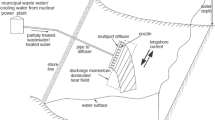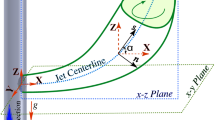Abstract
A comprehensive laboratory study of negatively buoyant discharges is presented. Unlike previous studies, here the focus is on generating data sets where influences of the bottom boundary have been eliminated. There are significant discrepancies in the published dilution data for these flows and a contributing factor is the large variation in the bottom boundary condition. A Laser-induced Fluorescence system is employed to gather flow spread, peak concentration (minimum dilution) and trajectory data for a wide range of densimetric Froude numbers and initial discharge angles. Data from these experiments are compared with previously published data, along with predictions from integral models and a revised form of the previously published semi-analytical solutions. The new data sets are not distorted by mixing processes associated with the bottom boundary and therefore provide the basis for more meaningful assessments of the predictive capabilities of existing models, given that the influences of the bottom boundary on contaminant mixing are not incorporated into these models. In general the models assessed are able to predict key geometric quantities with reasonable accuracy, but their minimum dilution predictions are conservative. Importantly dilution at the return point shows a strong dependence on the initial discharge angle and this could have important implications for the design of discharge systems.



















Similar content being viewed by others
References
Bloomfield LJ, Kerr RC (2002) Inclined turbulent fountains. J Fluid Mech 451:283–294
Bosanquet CH, Horn G, Thring MW (1961) The effect of density differences on the path of jets. Proc R Soc Lond Ser A 263(1314):340–352
Cipollina A, Brucato A, Grisafi F, Nicosia S (2005) Bench-scale investigation of inclined dense jets. J Hydraul Eng 131(11):1017–1022
Crowe A, Davidson MJ, Nokes RI (2010) Inclined Negatively Buoyant Jets and Seabed Impingement. 6th International Conference on Marine Waster Water Discharges & Coastal Environment (MWWD 2010), Langkawi, Malaysia, pp 25–29
Ferrari S, Querzoli G (2004) Sea discharge of brine from desalination plants: a laboratory model of negatively buoyant jets. In: Proceedings of 3rd International Conference on Marine Waste Water Disposal and Marine Environment
Jirka GH (2008) Improved discharge configurations for brine effluents from desalination plants. J Hydraul Eng 134(1):116–120
Kikkert GA, Davidson MJ, Nokes RI (2007) Inclined negatively buoyant discharges. J Hydraul Eng (ASCE) 133(5):545–554
Lai CCK (2010) Mixing of inclined dense jets. M.Phil. thesis, The University of Hong Kong
Lai CCK, Lee JHW (2012) Mixing of inclined dense jets in stationary ambient. J Hydro-Environ Res 6:9–28
Lane-Serff GF, Linden PF, Hillel M (1993) Forced, angled plumes. J Hazard Mater 33:75–99
Lattemann S, Kennedy MD, Schippers JC, Amy G (2010) Chapter 2 global desalination situation. In: Escobar IC, Schäfer AI (eds) Sustainable Water for the Future: Water Recycling versus Desalination, vol. 2. Elsevier, Amsterdam, pp 7–39
Lindberg WR (1994) Experiments on negatively buoyant jets, with and without cross-flow. In: Davies PA, Valente Neves MJ (eds) Recent research advances in the fluid mechanics of turbulent jets and plumes. Kluwer Academic Publishers, Dordrecht, Netherlands, pp 131–145
Marti CL, Antenucci JP, Luketina D, Okely P, Imberger J (2010) Near field dilution characteristics of a negatively buoyant hypersaline jet generated by a desalination plant. J Hydraul Eng 137:57–65
Nemlioglu S, Roberts PJW (2006) Experiments on Dense Jets Using Three-Dimensional Laser-Induced Fluorescence (3DLIF). In: 4th International Conference on Marine Waste Water Disposal and Marine Environment
Oliver CJ (2012) Near field mixing of negatively buoyant jets. Ph.D. thesis, University of Canterbury, New Zealand
Oliver CJ, Davidson MJ, Nokes RI (2013a) Predicting the near-field mixing of desalination discharges in a stationary environment. Desalination, 148–155 doi:10.1016/j.desal.2012.09.031
Oliver CJ, Davidson MJ, Nokes RI (2013b) The behavior of desalination discharges beyond the return point. J Hydaul Eng, ASCE
Otranto F (2004) Laboratory modelling of sea-brine discharges. The University of Western Australia, Undergraduate Report
Palomar P, Lara JL, Losada IJ (2012) Near field brine discharge modeling part 2: validation of commercial tools. Desalination 290:28–42
Papakonstantis I, Kampourelli M, Christodoulou G (2007) Height of rise of inclined and vertical negatively buoyant jets. In: Di Silvio G, Lanzoni S (eds) Proceedings of the 32nd IAHR Congress: Harmonizing the Demands of Art and Nature in Hydraulics. Fluid Mechanics and Hydraulics Theme
Papakonstantis IG, Christodoulou GC, Papanicolaou PN (2011a) Inclined negatively buoyant jets 1: geometrical characteristics. J Hydraul Res 49(1):3–12
Papakonstantis IG, Christodoulou GC, Papanicolaou PN (2011b) Inclined negatively buoyant jets 2: concentration measurements. J Hydraul Res 49(1):13–22
Papanicolaou PN, List EJ (1988) Investigations of round vertical turbulent buoyant jets. Journal of Fluid Mechanics 195: 341–391
Papantoniou D, List EJ (1989) Large-scale structure in the far field of buoyant jets. J Fluid Mech 209:151–190
Roberts PJW, Toms G (1987) Inclined dense jets in flowing current. J Hydraul Eng 113(3):323–341
Roberts PJW, Ferrier A, Daviero G (1997) Mixing in inclined dense jets. J Hydraul Eng 123(8):693–699
Saliby I El, Okour Y, Shon HK, Kandasamy J, Kim In S (2009) Desalination plants in Australia, review and facts. Desalination 249:1–14
Shao DD, Law AWK (2010) Mixing and boundary interactions of 30 and 45 inclined dense jets. Environ Fluid Mech 10(5):521–553
Vanvolsem M (2011) The Art of Strip Photography: Making still Images with a Moving Camera. Volume 11 of Lieven Gevaert Series. Universitaire Pers Leuven, Leuven, 212 p
Wang H, Law A (2002) Second-order integral model for a round turbulent buoyant jet. Journal of Fluid Mechanics 459: 397–428
Zeitoun MA, Mcllhenny WF, Reid RO (1970) Conceptual Designs of Outfall Systems for Desalting Plants. U.S. Dept of the Interior, Washington, p 1139
Author information
Authors and Affiliations
Corresponding author
Rights and permissions
About this article
Cite this article
Oliver, C.J., Davidson, M.J. & Nokes, R.I. Removing the boundary influence on negatively buoyant jets. Environ Fluid Mech 13, 625–648 (2013). https://doi.org/10.1007/s10652-013-9278-3
Received:
Accepted:
Published:
Issue Date:
DOI: https://doi.org/10.1007/s10652-013-9278-3




